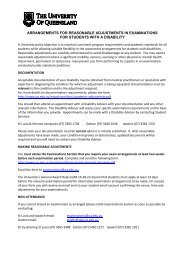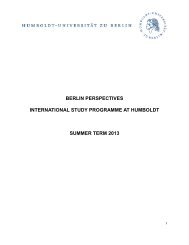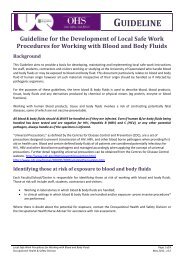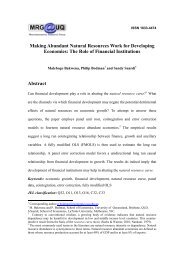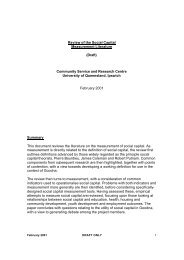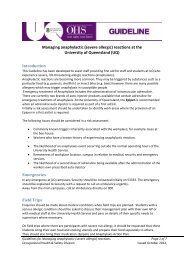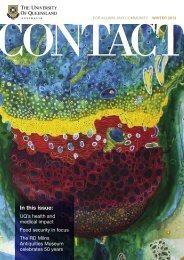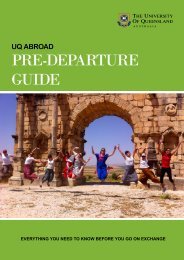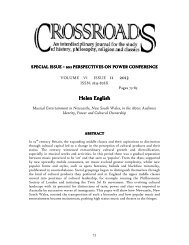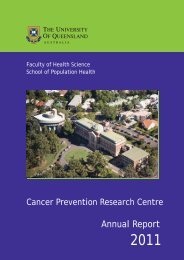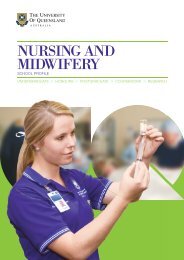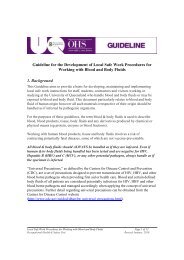Memmott, Paul and Chambers, Catherine - University of Queensland
Memmott, Paul and Chambers, Catherine - University of Queensland
Memmott, Paul and Chambers, Catherine - University of Queensland
You also want an ePaper? Increase the reach of your titles
YUMPU automatically turns print PDFs into web optimized ePapers that Google loves.
& Young (1998) was most wide ranging in the detail <strong>and</strong> depth <strong>of</strong> discussion it provided,while Olive (1992) <strong>and</strong> Berry, MacKenzie, Briskman & Ngwenya (2001) were found tobe useful in elucidating firstly an Indigenous women's perspective, <strong>and</strong> secondly theVictorian context.Of particular relevance to the current authors has been the notion <strong>of</strong> a cultural definition <strong>of</strong>homelessness that uses accepted community st<strong>and</strong>ards to objectively distinguish states <strong>of</strong>homelessness (as expounded by Chamberlain <strong>and</strong> others). We believe that if suchdefinitions were to be evolved for Indigenous Australians, they would have to embrace avery different cultural context: one in which some itinerant people prefer to live in publicplaces on a regular basis, in fact see these places as home <strong>and</strong> hence the term public placedwellers; <strong>and</strong> one in which many more people live in accommodation that puts them atrisk <strong>of</strong> homelessness. Unless service providers recognise these preferences on the oneh<strong>and</strong> <strong>and</strong>, on the other, the true nature <strong>and</strong> extent <strong>of</strong> housing stress amongst Indigenouspeoples, their efforts will continue to fail to some degree. These ideas have formed theframework <strong>of</strong> thinking for this paper.METHODOLOGYThe Aboriginal Housing Company required that the field research be qualitative ratherthan quantitative, incorporating aspects <strong>of</strong> participatory action research <strong>and</strong> narrative datagathering, therefore the approach in the field focussed on encouraging people to tell theirstories in as much detail as possible. This style <strong>of</strong> information gathering, by the Aboriginalfield researchers discussed below, as well as the pace at which work was conducted,resulted in a certain conflation <strong>of</strong> causes <strong>and</strong> symptoms in the field workers’ reports.Although this conflation may seem methodologically problematic to certain critics, wehave taken it as a fieldwork limitation <strong>of</strong> the Indigenous narrative approach.Beside the team in Brisbane, two locally-based field researchers were employed to engagewith the relevant communities <strong>and</strong> identify potential participants over a period <strong>of</strong> sixmonths: these were Mr Richard Greene <strong>of</strong> the Daruk language group <strong>and</strong> Ms Pam Ingram<strong>of</strong> the Wiradjuri language group. Both were long-term residents <strong>of</strong> inner-city Sydney <strong>and</strong>familiar with its Aboriginal community. They had also experienced, <strong>and</strong> indeed as iteventuated were continuing to experience, similar types <strong>of</strong> problems to those theyinterviewed. The field team was led by Ms Angela Pitts, a part-time social planningconsultant to the AHO in Redfern who was also carrying out doctoral research at the<strong>University</strong> <strong>of</strong> Sydney.The scope <strong>of</strong> the project meant that all circumstances reported by the respondents, such asstates <strong>of</strong> substance addiction or mental health issues, were not otherwise verified <strong>and</strong>further explained. As the field researchers were able to establish a rapport withindividuals, the interviewing process could be reflexive, allowing for the incorporation <strong>of</strong>changes as work proceeded <strong>and</strong> new insights emerged into how best to gather <strong>and</strong> analysethe information received.Of the interviews conducted with 53 homeless people, eight were developed intocomprehensive case studies. Two different interview designs were used for public placedwellers <strong>and</strong> those insecurely housed (Refer to Appendix 1 in <strong>Memmott</strong> et al 2005). Inaddition to the one-on-one structured interviews, informal interviewing occurred withstreet groups to aid the field researchers in their pr<strong>of</strong>iling tasks, <strong>and</strong> enable them toexplore more fully such issues as group identity <strong>and</strong> territory or ‘beat’, the types <strong>of</strong>services accessed <strong>and</strong> perceived lifestyle issues.Homelessness Amongst Aboriginal People in Inner Sydney Page 3


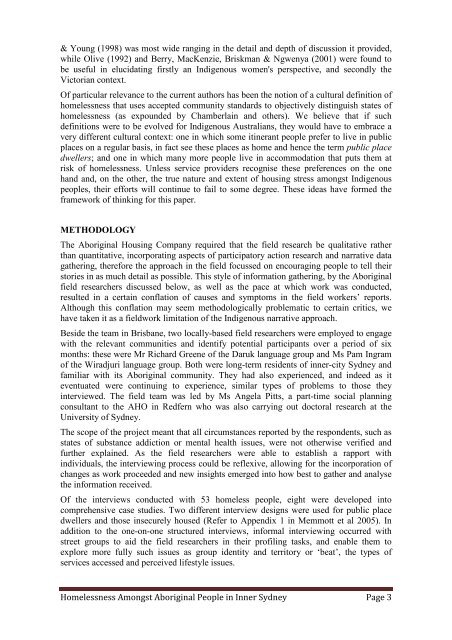

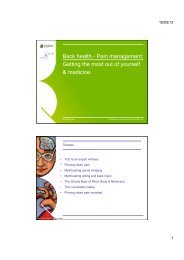
![Recycling [ PDF, 62KB ] - University of Queensland](https://img.yumpu.com/51805185/1/184x260/recycling-pdf-62kb-university-of-queensland.jpg?quality=85)
